Back in December I reviewed the first season of The Dangers in My Heart, an anime series about the growing relationship between Kyoutarou Ichikawa, a short anti-social middle school boy, and Anna Yamada, his tall, friendly, goofy classmate who works as a professional teen fashion model and actress. The first season aired in the season of 2023. The second season ran for 13 episodes in the winter season of 2024. While my overall impression of the first season was positive, my issues with the first half left it a few spots outside my year-end top-six anime ranking for 2023.
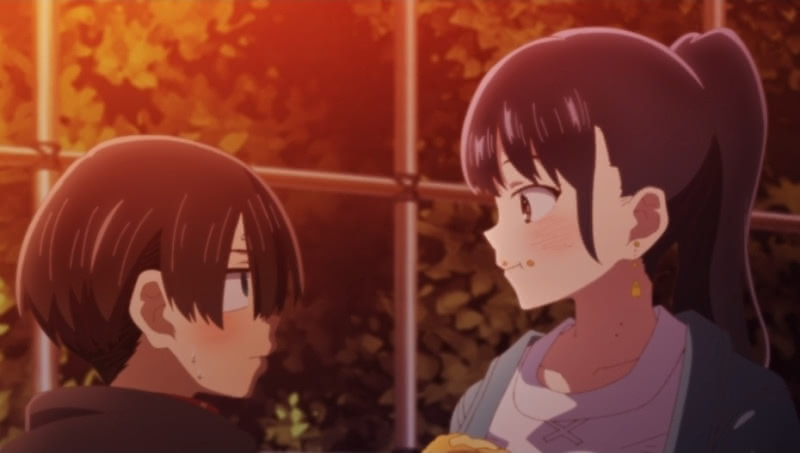
Its second season, however, will have no such ranking let-down in 2024. For reasons I explain below, the second season of The Dangers in My Heart, which built off the first, is the first genuine anime of the year contender for 2024 (on my subjective list, at least) and one of the finest examples of a middle/junior high school-based story in TV anime.
Prefatory notes on spoilers
This is my second consecutive anime review of a second season anime, having recently covered fellow winter 2024 show Bottom-tier Character Tomozaki-kun 2nd Stage. I explained with respect to spoilers in that review that my usual method of reviewing first or single season shows in a largely spoiler-free manner does not neatly apply to subsequent season shows. Similarly to Tomozaki, the second season of The Dangers in My Heart requires knowledge of its first season. This review presupposes familiarity with the first season of The Dangers in My Heart or, at a minimum, my review of the first season. If you are not already up to date on the first season or my thoughts on it, you should read my review of season one before this review.
With respect to the second season, I will refrain to the greatest extent practicable from discussing specific plot events in detail – more so than I did in my review of the second season of Tomozaki because I think that The Dangers in My Heart is more amenable to discussing in general terms. If you have already watched the first season and plan to watch the second (either because it was already on your list or you are inspired by the introduction to my review), you may consider whether you want to read my review before or after watching the second season. I wrote the review in such a way that it should be of interest to people who have already watched the second season and want to read my opinion of it (e.g., I refer to specific episodes to highlight some things I like and dislike and those references will be intelligible to those of you who have already watched the season).
The Dangers in My Heart S2 Details
Both seasons of The Dangers in My Heart are based on an ongoing manga series by Norio Sakurai and both seasons were produced by the same studio with the same key players in the production. While I am not familiar with the manga source material, my understanding is that the two seasons of the anime broadly adapted the first six out of 10 manga volumes (the 10th volume of the manga was released on Japan on April 8, 2024).
- Title:
- The Dangers in My Heart (EN)
- Boku no Kokoro no Yabai Yatsu (JP)
- Aired: January 7, 2024 through March 31, 2024 (13 episodes)
- Studio: Shin-Ei Animation
- Director: Hirokai Akagi
- Series Composition: Jukki Hanada
- Source Material: Ongoing manga by Norio Sakurai
- Links: Anime News Network; My Anime List; AnimeDB, Wikipedia
Both the studio (Shin-Ei Animation) and director (Hirokai Akagi) behind The Dangers in My Heart also handled the Teasing Master Takagi-san series (2017-22). The third season of Teasing Master Takagi-san was my 2022 anime series of the year. The main writer, Jukki Hanada, has been the writer behind the ongoing Sound! Euphonium series (2016-24), which has its third season airing as I am writing this article (spring 2024). I chose the first two seasons of Euphonium as an honorable mention choice recommended anime series for general audiences from 2011-2020 and one of my top-three series in both 2016 and 17. Suffice it to say, the anime adaptation of Ms. Norio Sakurai’s manga series has a strong team behind it.
First Season Recap
I recommend reading my review of the first season for a general overview of what transpired before the season being reviewed in this article. To begin, I incorporate by reference my general overview from my season one review. Below, I will build off what I wrote there to add some additional detail and context to set up the second season.
The first season of The Dangers in My Heart focuses on the character growth and development of the 13-year old Kyoutarou Ichikawa. When we first meet him, he is completely alone and trying to explain this state away by pretending in his head that he is “dangerously unstable.” His unhealthy fixation with his tall, attractive, professional model classmate, Anna Yamada, quickly turns into friendship when their interactions in the school library (where Anna hides to eat snacks and Kyoutarou hides to be alone) and when Kyoutarou’s obsessive focus on Anna leads him to do nice things for her.

Kyoutarou realizes that he is actually in love with Anna after his worst (and last) internal creepy moment in the fourth episode – when, after having already come to know her a little bit as a person, he comes to understand that she is not as confident as one may think and takes her work as a model and aspiring actress seriously. By the fifth and sixth episodes, which see Kyoutarou and Anna get separated from the rest of the class on a trip, it becomes obvious that Anna is developing her own feelings for Kyoutarou – something Kyoutarou does gradually pick up on but refuses to let himself actually believe for most of the first season. Kyoutarou’s struggle to believe that Anna is genuinely fond of him and Anna’s subtle shyness leads to some misunderstandings. For example, Anna’s indirect methods of asking Kyoutarou for his LINE (a popular instant messaging service in Japan) contact information leads to Kyoutarou initially missing the point. Kyoutarou briefly convinces himself that Anna is using him to avoid attention from a guy she is not interested in – which was true in one case but ignores the fact that Anna is actually interested in Kyoutarou.
Kyoutarou’s stand-out trait is that, while he lacks confidence, introspective to a degree that causes him trouble, and has difficulty understanding people’s intentions with respect to him (a classic introvert characteristic in school anime), he is intelligent – a point made even more explicit in the second season. Anna is not as book smart as Kyoutarou, but she has good social skills, a big heart, and proves to be able to see through his lack of self-confidence. Between Anna’s patience with Kyoutarou and Kyoutarou’s ability to think through situations and willingness to adjust his prior assumptions in the face of new evidence, they are able to work through their misunderstandings with surprisingly little drama – all the more impressive in light of the fact that they are 13 in the first season.
Kyoutarou’s and Anna’s relationship warms further late in the first season. Episode 10 has Anna dragging Kyoutarou out on Christmas Eve (note Christmas Eve is a popular date day in Japan) for what is so obviously a date, especially when it ends with them holding hands. Kyoutarou has to work harder than usual to deny what is obvious to astute observers. Episode 11 has Kyoutarou breaking his arm while he is on a family vacation for New Years (a situation that persists into the beginning of the second season) while trying to take a picture to send to Anna.
The first season left much of its important development for the final episode – which takes place on New Year’s and right after school resumes. Anna, at the invitation of Kyoutarou’s older sister Kana Ichikawa, visits their house and sees photos from Kyoutarou’s time before he attended their current school. We learn that Kyoutarou had been separated from his friends because he was not accepted into the same selective middle school, despite having been a good student. It was that event that paved the way for Kyoutarou losing his self-confidence and isolating himself from others. In an emotional scene on their first day back at school, Kyoutarou thanks Anna for being the reason he could enjoy going to school again. Anna, who we know less about since the series is seen from Kyoutarou’s perspective, evinces a keener understanding of Kyoutarou than she lets on by telling him that he should credit himself for putting the work in to change his outlook and make school enjoyable.
Before continuing to my review of the second season, I will note some specific classmates who played a role in the first season and who also play a role in season two. Note that all of the characters listed below with the exceptions of Kana and Haruya are in the same class as Kyoutaro and Anna.
- Moeko Sekine (voiced by Megumi Han): Sekine is a flashy, energetic girl who is part of Anna’s friend group. She is the first of the girls to befriend Kyoutarou to some extent (part of the LINE conflict started when Sekine got Kyoutarou’s contact information by simply asking him directly). She is one of the first characters to pick up on the fact that Kyoutarou and Anna are close. She facilitates their coming together and saves them from awkward situations on a few occasions.
- Chihiro Kobayashi (voiced by Ayaka Asai): Another girl in Anna’s friend group. She is Anna’s best friend and errs on the blunt side.
- Kenta Kanzaki (voiced by Gen Satou) and Honoka Hara (voiced by Aki Toyosaki): Kanzaki is a nice boy who has a thing for chubby girls. Hara is a chubby girl (she wants to change that) who likes Kanzaki. Anna and Kyoutarou play a role in helping them get together and Kanzaki and Hara are probably the first two classmates (close with Sekine) to pick up on something between the main pair.
- Shou Adachi (voiced by Nobuhiko Okamoto): An immature classmate of Kyoutarou’s who repeatedly tries to trick the girls into saying something sexually awkward. On several occasions, Kyoutarou subtly tries to do something to keep Anna and her friends from falling for Shou’s tricks – something Anna and Chihiro may be more likely to fall for than Sekine and a couple of other girls in the group. Despite Shou’s particularly middle school brand of unfortunate tendencies, he shows on rare occasions in the first season that he can be earnest (he has more character development in season two).
- Haruya Nanjou (voiced by Nobunaga Shimazaki): An upper-classmate of Anna and Kyoutarou by one year. He is handsome, has a reputation for hitting on girls, and has a particular interest in Anna. One of Kyoutarou’s first “white knight” moments has him intervening when Nanjou is making Anna uncomfortable in his attempts to get her number. Nanjou causes a second conflict later in the season when he takes advantage of Kobayashi’s naivete to try to get close to Anna. Anna uses Kyoutarou – who we know she has genuine feelings for – to throw Nanjou off.
- Kana Ichikawa (voiced by Yukari Tamura): Kana is Kyoutarou’s older sister. She is a college student and is shown to initially be the only person whom Kyoutarou is close to. She takes an immediate liking to Anna and gives Kyoutarou advice while also sometimes teasing him.
Second Season Review
As I noted at the top, I will discuss the second season in general terms and try to refrain from spoilers to the greatest extent practicable. For this review, I will lead with my discussion of the story and themes before a separate section on the aesthetics and other production notes.
Story Review and Analysis
Season two picks up right where the first season left off – evinced by the fact that one of the central story-lines in the first episode focuses on Kyoutarou’s arm still being in a cast from his winter break injury in the penultimate of the first season. It should be obvious to anyone who watched the first season that Kyoutarou and Anna have mutual feelings for each other and it is so obvious by this point that Kyoutarou acknowledges it in his head to some extent while still refusing to admit the obvious outright. One thing that will have to, and does, change in the second season is how Kyoutarou and Anna behave at school. Kyoutarou was uncomfortable for many reasons about being seen as close to Anna (Anna is unsurprisingly popular with boys because of her appearance), and Anna agreed to keep her distance in school. The first episode features Kyoutarou telling a teacher he could not ask Anna for help navigating school with his broken arm because they were not friends. While Anna, who overheard the conversation, was initially hurt – the misunderstanding was resolved fairly painlessly due to Anna’s understanding Kyoutarou’s perspective and insecurities and Kyoutarou’s quickly making amends and apologizing.
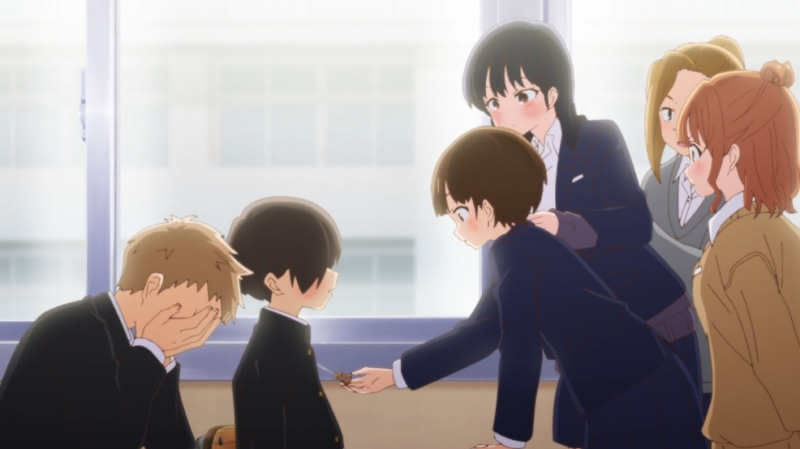
Season two is broken roughly into two halves – with a dramatic event centering on the changing of one school year to the next (note the new school year in Japan begins in April) occurring in episode six. Kyoutarou is chosen by his teacher to give a speech as the representative of his class at the graduation ceremony for the outgoing seniors one year above, largely on account of the fact that we learn Kyoutarou ranks second in his class . While I will not discuss in specific detail what occurrs – it suffices to note that this is a major event for Kyoutarou’s character development (and by extension, his relationship with Anna). The second half of the season – episodes 7 through 12 – picks up with the start of the new school year and the introduction of some new classmates, namely Yurine Hanzawa (voiced by Reina Ueda) and Kanna Andou (voiced by Yuka Iguchi). Andou has an unhealthy interest in trying to force prospective couples to confess to one another in public. The second half of the season culminates with a school trip that proves to be important for both Kyoutarou and Anna.
Before the climax of the first half of the second season – both Kyoutarou and Anna undergo some significant character development. Some of this is simply their natural progression from the first season – with season two picking up with them already being close friends. One point I appreciated is that the second season quickly begins addressing a lingering issue I had with the first. We always know exactly what Kyoutarou is thinking because we, the viewers, see everything from his perspective. That, combined with Kyoutarou’s being articulate and intelligent, means we never have to guess where he stands. While we saw plenty of Anna in the first season and it was obvious enough that she is kind, has her own share of insecurities, and likes Kyoutarou, I opined in my review that some of Anna’s motivations, including what precisely drew her to Kyoutarou, remained a mystery. Season two does a great deal to shed more light on who Anna is as a person – no doubt helped by the fact that her closest friend by this stage is the view-point character. It is clear that Anna sees Kyoutarou as a good person who cares about her, and she respects his intelligence and way of seeing different situations. We finally learn more about why Anna lacks self-confidence and what drives her to work so hard at modeling and trying to be an actress. We also learn in more explicit terms her approach to becoming closer to Kyoutarou and working with his own insecurities and lack of self-confidence, which serves to further demonstrate that she is more insightful than one would think at first glance. Just as importantly, we also meet Anna’s mother (voiced by Yuuko Minaguchi), giant father (voiced by Yoshimasa Hosoya), manager, Yuuki Suwa (voiced by Mistuki Saiga), and Nico Kouda (voiced by Rio Tsuchiya), one of her colleagues. All of these characters, along with some of Kyoutarou’s interactions with Sekine and Kobayashi, leave us with a much better understanding of Anna than in the first season.
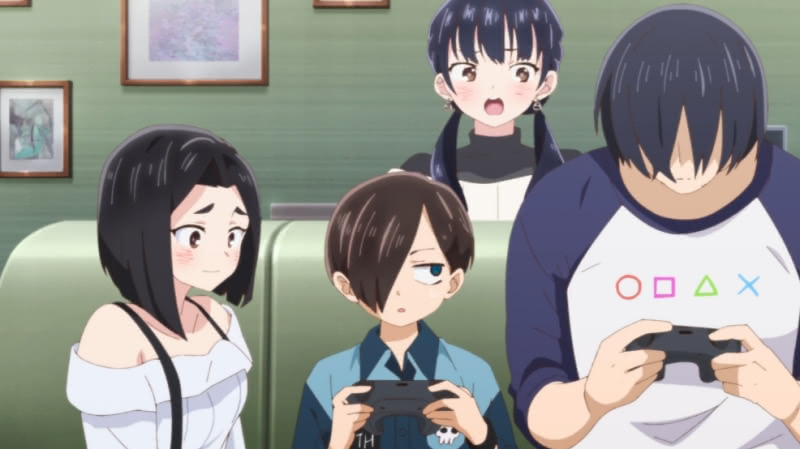
I noted in my review of the first season that Kyoutarou has a dramatic character transformation – going from a creepy edgelord who harbors disturbing fantasies to rationalize his depression, lack of self-confidence, and loneliness – to someone who falls in love and can sincerely say that he looked forward to going to school. Despite starting from a much better place in the second season than the first, his character growth is no less dramatic. One notable point is that, while the second season never forgets that Dangers is in significant part a love story, the main focus is always on character growth, most prominently, but not limited to, Kyoutarou and Anna. Kyoutarou steps further out of his comfort zone in the second season, attending a gettogether at Anna’s house as the only guy (an event that not only allows Kyoutarou to meet Anna’s parents but also gives Sekine a chance to shine), attending a karaoke event, becoming more friendly with his classmates, asserting himself and his feelings with confidence, and being asked to deliver a speech as representative of his class at the end of the school year. As Kyoutarou begins to come to terms with the fact that Anna does actually like him, he begins to consider what he is to Anna, especially after gaining a better understanding of her work as a model and actress, the fact that she is somewhat popular, and what she hopes to achieve. One moment I particularly appreciated in the second half is when Kyoutarou remembers his painfully creepy fantasies from the beginning of the first season and suffers some sharp pangs of embarrassment when he thinks back to where he had been a year earlier.
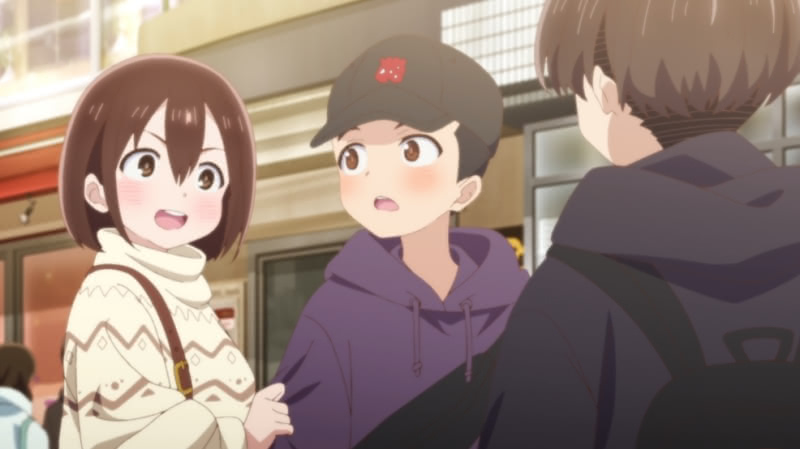
Dangers is hyper-focused on Kyoutarou and Anna, but I credit the second season for doing more with the supporting cast. Kana, Kyoutarou’s older sister, is one of the best secondary characters in her limited screen time in the first season, and she continues on that track in her second season. The show’s writers and artists do a terrific job of portraying the close relationship she has with Kyoutarou and how Kyoutarou trusts her and values her opinion even through their sibling banter (e.g., one of my favorite scenes of the season has Kyoutarou waking Kana early in the morning to get her opinion of his outfit before he goes out to meet Anna). The best comedy of the season is delivered by Anna’s friend Moeko Sekine, who makes the most effort of Anna’s group to befriend Kyoutarou. Sekine continues to support Anna and Kyoutarou while sometimes taking too much advantage of her opportunities to save them from awkward situations. While she plays dumb, her intelligence is clear without it having been noted that she ranks fifth in the grade academically (recall Kyoutarou is second).
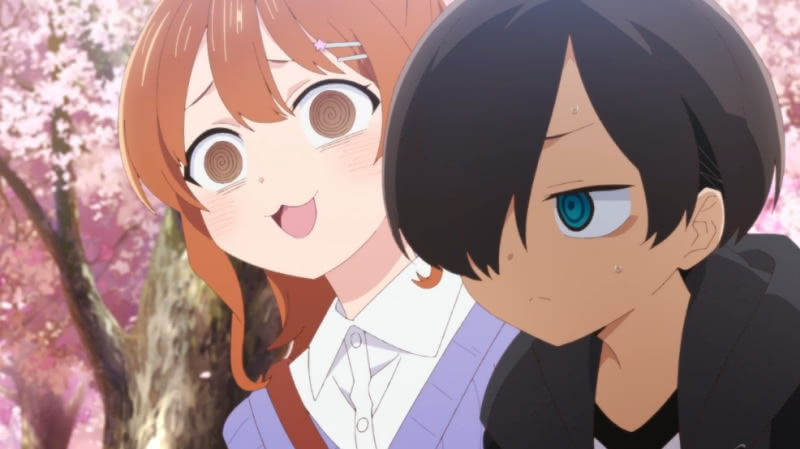
I hope Sekine plays a bigger role if there is a third season. Kanzaki and Hara play a more key role in the second season which gives some small insights into their relationship beyond the role they play with Kyoutarou and Anna. Shou, whose main role was having the dirtiest mind of the middle school boys, shows some actual growth in the second season and becomes a real friend for Kyoutarou – although I will note his main story-line goes a bit too far into melodrama territory and his base middle school boy tendencies are still present. Finally, Anna’s parents – especially her newly introduced father (her mother made a very small appearance in the first season) are both fun and meeting them sheds some important light on Anna.
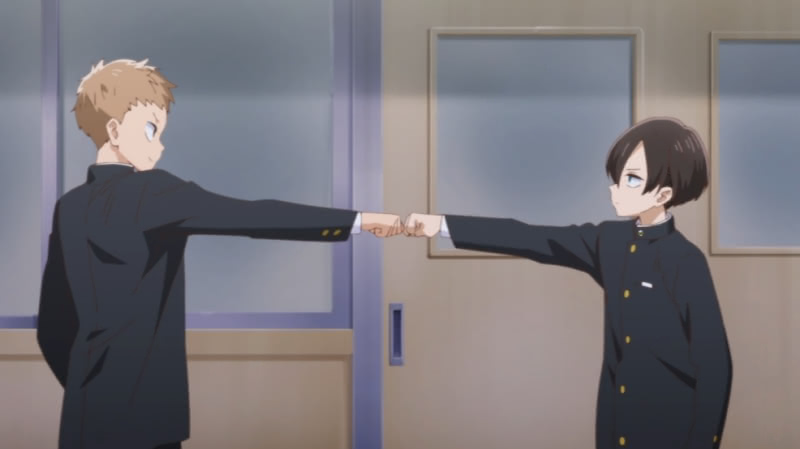
One of the most impressive points of The Dangers in My Heart is how well it handles distinctly middle school characters. It is more impressive in this specific regard than my middle school-based 2022 anime of the year, Teasing Master Takagi-san season 3, largely on account of its more serious tone and subject matter. As I noted in an article about a certain six-year-old visual novel character, when writing young characters it can be difficult to strike a balance between giving them a sufficient vocabulary to express themselves in a compelling way and making them so sophisticated that they lack credibility as young characters. Dangers strikes the balance. Kyoutarou possesses above average intelligence which, combined with his insecurities and blind spot regarding how people think of him, sometimes leads him to the correct answer and other times causes him to think himself into a pretzel. That Kyoutarou is smart is important in that it allows him to express himself in an interesting way. But he is always written credibly for his age and is less prone to the sort of mental abstractions that are common in high school-based series such as Oregairu or another series that saw its second season air in winter 2024, Bottom-tier Character Tomozaki. His older sister, Kana, sometimes helps him see things he misses or refuses to admit on his own precisely because she views his situation from the perspective of someone who is older but not too far removed from where he is in life.
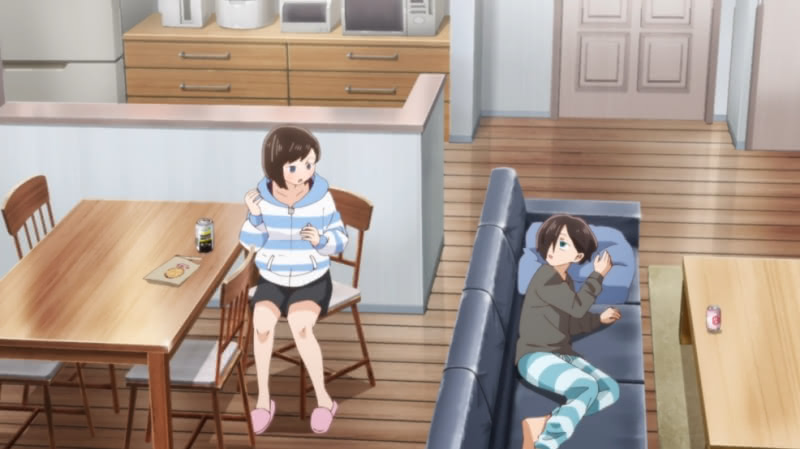
Similarly to Kyoutarou, while Anna looks older than she actually is – those moments when she lets her guard down about her feelings around him reveal that she is very much still a young girl. Another area that Dangers strikes the correct balance is with romance. Understanding the second season requires understanding that Kyoutarou and Anna are 13-14 (they both turn 14 in the second season) and have no prior experience with the feelings they develop. They both – especially Kyoutarou – have some apprehension about growing up and understand to some degree that their changing feelings are a product of becoming older. While many anime series use contrivances to drag out will they or won’t they scenarios between characters who clearly like each other, Dangers does a good job of addressing why Kyoutarou and Anna are, in light of their age, generally fine with the status quo so long as things keep progressing at their own pace. Finally – perhaps most important to understanding Dangers is that little things – achievements and milestones – that would be inconsequential to an adult or perhaps even to a high school student, are very important to Kyoutarou and Anna.
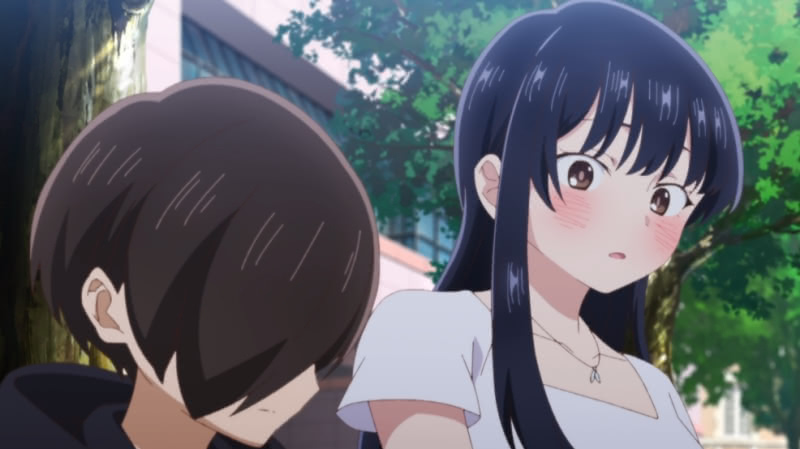
While my overall impression of the second season of Dangers are overwhelmingly positive, it had some more annoyances and inconsistencies than did the most recent anime of the year caliber middle school season I watched, Takagi-san season 3 in 2022. There were instances when the writing was a little bit heavy-handed at key points (see e.g., something concerning Anna’s work in episode 5), and very occasional moments when it felt like it regressed(see e.g., first half of episode 7). Episode 11 suffers from an unnecessary excess of melodrama that felt out of line with the general tone of the season. While the final episode stands with episode six as a genuine episode of the year caliber production, the quality of the second half of the season, while excellent on the whole, is more uneven than the first (a minor reversal from the first season – granting the second season’s much higher baseline). There were a few cases wherein I thought the writing makes use of too many conveniences to create an awkward and comedic situation for Kyoutarou and Anna (see e.g. certain events in episodes 2, 9, 12, and 13), but the show handles the aftermath of these situations more than well enough to make these occasional excesses forgivable. Of the new characters – Kanna Andou and her passion for celebrating new couples feels contrived to put additional pressure on Kyoutarou and Anna to fully acknowledge their feelings, but again, the series ultimately settles affairs well enough to even make the irriating Andou mostly forgivable.
Aesthetics and Production Review
The second season of The Dangers in My Heart returns the same team from Shin-Ei Animation that handled the first season. Unsurprisingly, the audio-visual style is unchanged, so I incorporate by reference my thoughts on the aesthetics from my first review. The second season distinguishes itself in that the overall animation quality – which was already high for a slice of life school romantic comedy/drama – is more consistent than in the first season and the second season shows more of a second gear for big moments – most notably in episodes 6 and 13. While Dangers’s second season will no more challenge the top-tier TV anime productions than the first, it is well above average overall and even more so for the genre.
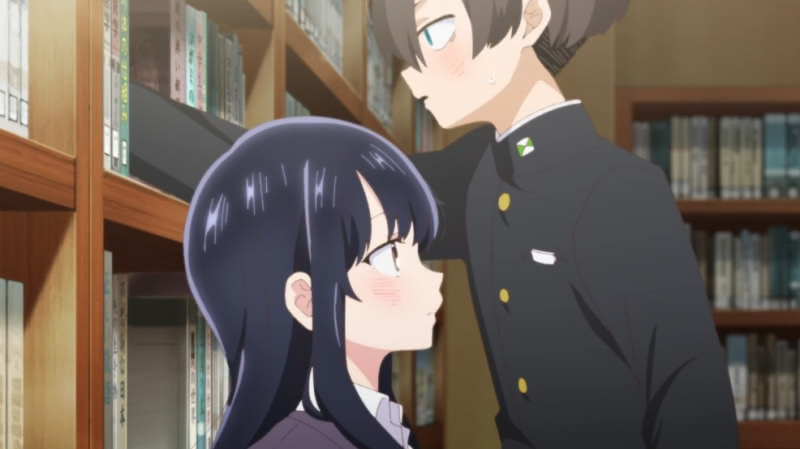
Regarding the animation and visuals – I will single out one unique second season point for special mention. Kyoutarou grows a couple of inches in the second season and his voice becomes slightly deeper. I single this point out for mention because I actually noticed in the episode where it was an issue that Kyoutarou seemed ever so slightly taller before it was commented upon. In light of the fact that he is still a good amount shorter than Anna even with his growth spurt, I appreciated the care that went into depicting his growth along with his voice change (credit to Shun Horie) that it was noticeable before it becomes a conversation topic. The anime’s handling of Kyoutarou’s literal growth is a neat flourish that highlights the particular strengths of the medium – showing before telling in a way that would be much more difficult in manga form.
On the subject of voice actors and actresses – Mr. Horie puts in another great performance as Kyoutarou. Of the more minor characters, I was partial to Ms. Megumi Han’s performance as Moeko Sekine – which I suppose should be no surprise in light of the fact I gave a character voiced by Ms. Han my nod for female character of the year in 2023 (Kana Arima from Oshi no Ko).
The audio side of affairs continued to be solid – and it used its musical selection well for big scenes (see e.g., episode 13). Like the first season, Shin-Ei Animation invested in both the opening and ending songs. The opening sequence was highly animated and featured I Am… by Atarayo. The ending sequence was not animated but instead featured a slide show of scenes from Kyoutarou’s and Anna’s past – it was accompanied by I Can Even Love My Loving Self by Kohana Lam (who also performed the ending song for season 1). Both of the songs matched the series well – albeit I think the opening for season one (Setting Sun by Yorushika) was the best of the four opening and ending sequences (it makes an important cameo in season two). While the animation in the opening was impressive and among the higher production opening or ending sequences you will find in TV anime, the slideshow from Kyoutarou’s and Anna’s past with the ending added something unusually meaningful for an opening or ending sequence.
Conclusion
My tastes in anime do not always match the crowd. For example, I did not note the appearance of my 2023 choice for anime of the year, Overtake!, on many of the best of lists. But there are other occasions when my tastes happen to match up. The second season of The Dangers In My Heart swept the top spot on Anime News Network’s cumulative ranking for the entire winter season (fun note: the other two winter 2024 series I reviewed in full article form, A Sign of Affection and Bottom-Tier Character Tomozaki, finished the season at 4th and 16th respectively). According to Guardian Enzo of Lost in Anime, The Dangers In My Heart cleaned up in several popularity contests in Japan as well (note: be warned that link discusses episode 10 in detail). The crowds are often wrong (from what I have gleaned and in my humble opinion), but not always – Dangers season 2 is very good.
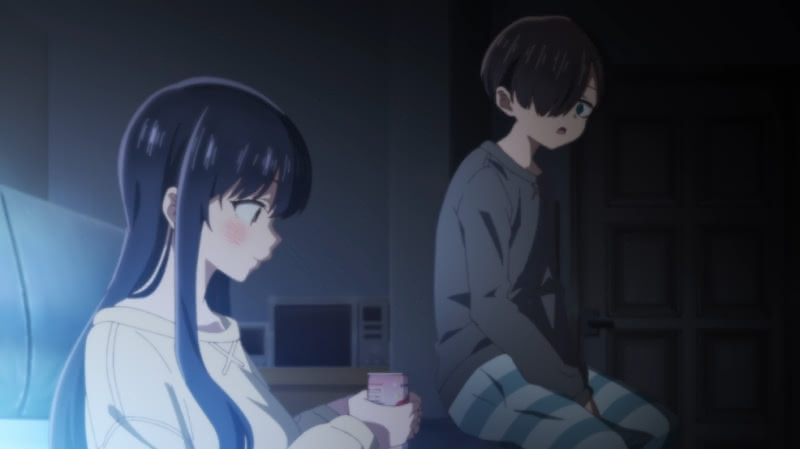
The first season fell several spots outside my 2023 top-six, although I gave Kyoutarou the fourth spot on my best male character ranking as a consolation prize – which was no small feat given his very poor first impression. I opined that in light of the first season’s second-half improvement, the second season seemed like a solid prospective top-six candidate. Thus, I had some expectations for it – but I did not expect an anime of the year caliber production following a borderline top six series in a weak year (e.g., it would have made my 2022 top-six but not my 2021 list). But the second season surpassed my modest expectations and is, based on my past anime of the year winners, a plausible anime of the year caliber piece. While it is far too early to say more of its 2024 prospects on my list other than that it was the best show of the winter season, I will note that it would have been my choice for anime of the year against the 2023 competition.
The Dangers in My Heart season two is the third elite middle school show with romantic elements since 2017, following Tsuki ga Kirei, which was my 2017 anime of the year, and the third season of Teasing Master Takagi-san, which took the honors on my 2022 list (honorable mention to Takagi-san’s second season, which was my runner-up selection in a weak 2019). All three series highlight some reasons why anime is sometimes more comfortable with middle school than the far more common high school setting. Thematically, Dangers falls somewhere between its two anime of the year caliber middle school predecessors. Tsuki ga Kirei played a coming-of-age romance dead straight and featured little in the way of comedy or significant drama. The third season of Takagi-san showed more range in terms of character growth and development than the heavily comedy-slanted first two seasons, but its over-arching focus was still comedy. Dangers is at its heart a story about how Kyoutarou and Anna grow through their friendship with and feelings for one another, but it is more comedic than Tsuki ga Kirei, more dramatic than Takagi-san, and more introspective and densely written than both. This is not to say it is the best of the trio – that honor goes to the sublime Tsuki ga Kirei in my book, but between Dangers’ setting, high writing quality, and focus on showing subtle character development through little milestones, it carves out a unique place for itself among the better anime series in recent memory.
(Note: I suppose we can call Mr. Hiroki Akagi, the director of both Takagi-san and Dangers, the master of the middle school of the moment in the TV anime context.)
This brings us finally to my recommendations. I wrote the following with respect to its first season:
In general, slightly above average would entail a qualified recommendation. In Dangers case, I give the first season a very qualified recommendation in a vacuum (meaning without reference to the soon-to-air second season) because its unpleasant early quirks and general subject matter are not for everyone.
It should go without saying that in light of the fact I rated the second season as an anime of the year caliber piece, I must upgrade my recommendation for the first season – which now must be understood in the context of what it builtt toward. With that being said, the second season does not eliminate all of the issues I had with the first season – which I adjudicated, and still adjudicate, as slightly above average. For example, while the fact that Kyoutarou is a creepy little kid at the start of the first season is a necessary point in many respects since a major point of the show is his journey from self-imposed isolation to someone who can accept himself and those around him, I still think that the first season was unnecessarily edgy in the first few episodes (note I did not read the source material, but I understand the anime made some minor modifications to it at other points). Granting the first season picks up after episode 5 or so, its best moments are still less compelling than the second season. But for a series to improve in subsequent seasons is nothing unusual. For example, while I liked all three seasons of Takagi-san more than the first season of Dangers, the third season of Takagisanwas a dramatic step up in overall quality from the first two. In the end, I now recommend with confidence both seasons of The Dangers in My Heart based both on the solid second half of the first season and the anime of the year-quality material in the second, but my recommendation comes with some of the genre qualifications I noted in the first. The second season, like the first, still exists very much between Kyoutarou’s ears. While both he and Anna make great progress as people, their progress is that of 13 and 14 year old kids. Things that are dramatic to them are dramatic in a specific time and place in their lives. Little milestones like successfully navigating Valentine’s Day and White Day or giving a speech in front of your peers are milestones in a specific context. As good as the writing and production is in the second season, one’s mileage with the characters, settings, and themes may vary. My high recommendation comes with that context noted.
Given the popularity of the first two seasons of The Dangers In My Heart and that the underlying manga is ongoing, I hope to and expect to see a third season down the line. The third season would start from a much different place than both the first and the second – so I look forward to seeing the continuation whenever it arrives.